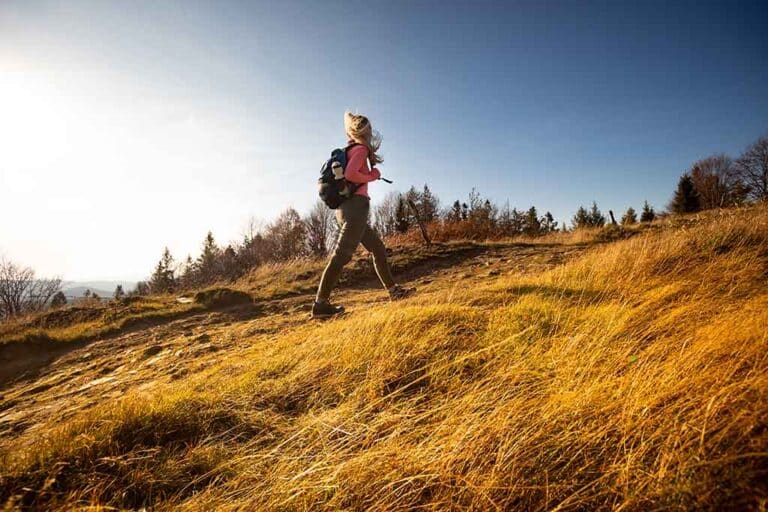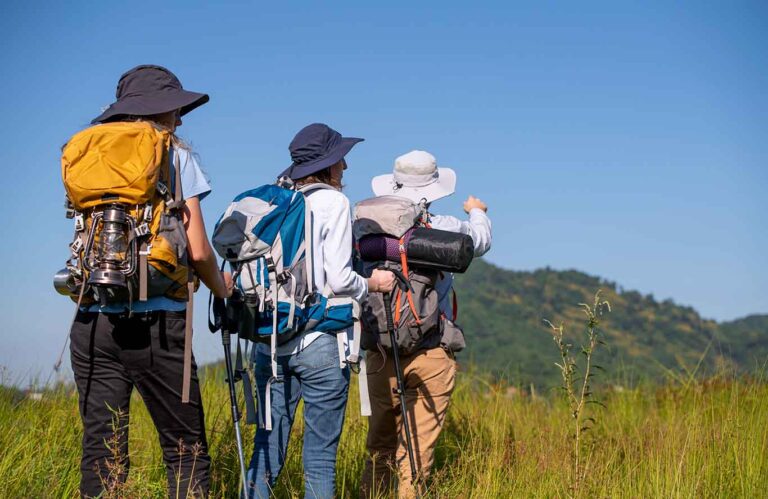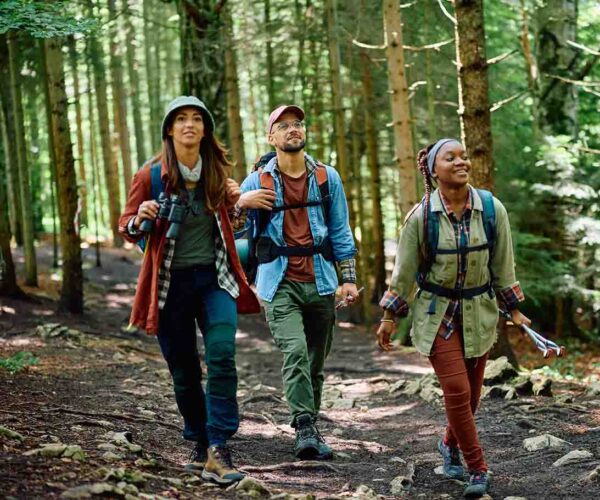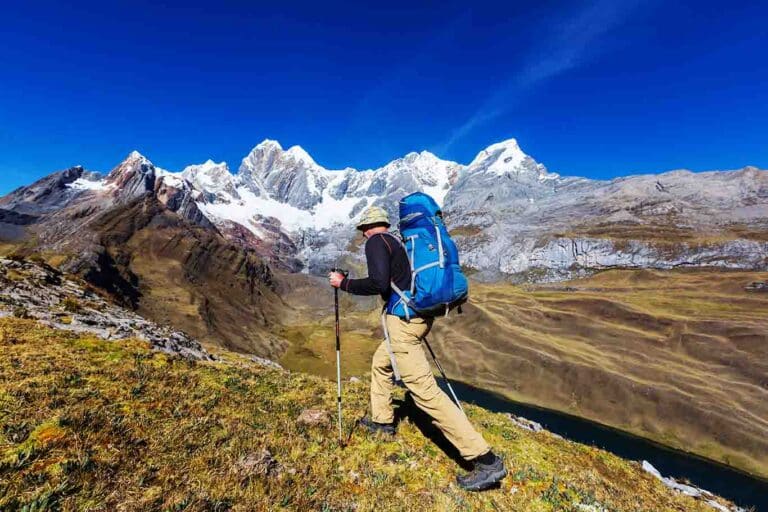Hiking and trekking are often spoken about as if they mean the same thing — and while they do share some similarities, they are quite different in practice. Whether you’re setting off for a gentle countryside walk or planning an epic multi-day mountain route, understanding the differences between these on-foot adventures is key to choosing the right experience for you.
Isn’t it all just walking though? Well, yes – but knowing what type of adventure you’re embarking on not only helps you enjoy your time outdoors more fully, but also ensures you’re prepared for what lies ahead. From carrying the right gear to training appropriately and understanding altitude challenges, being well-informed reduces risk, improves comfort, and boosts your confidence. Whether you’re a beginner or an experienced outdoor enthusiast, knowing the distinctions will help you safely and successfully plan your next journey on foot.
We compare hiking and trekking side by side, helping you understand how they differ in terms of duration, terrain, difficulty, fitness levels, and equipment. We’ve also covered other related activities like hill walking, scrambling, mountaineering, and backpacking, showing where they fit on the spectrum of walking adventures.
Hiking vs Trekking: What’s the difference?

Hiking and trekking are both rewarding ways to explore the outdoors, but they vary significantly in their nature and demands.
Hiking typically refers to a leisure activity involving walking on well-maintained paths or trails, usually in accessible areas such as national parks or rural countryside. It is generally a day-long activity, often requiring minimal preparation and gear.
Trekking, by contrast, is a more strenuous and immersive experience. It involves walking over multiple days, often through remote and challenging terrain. Trekkers usually carry more equipment, may camp or stay in basic lodges, and require a higher level of physical endurance.
Though similar in concept, hiking and trekking differ in several key aspects:
| Feature | Hiking | Trekking |
Duration
| Usually, a single day
| Multi-day journey
|
Terrain
| Well-marked trails
| Varied, often remote paths
|
Difficulty
| Easy to moderate
| Moderate to challenging
|
Accommodation
| Return home or day shelter
| Camping or remote lodges
|
Load carried
| Light daypack
| Larger backpack with essentials
|
| Accessibility | Easily accessible trails | Remote, less accessible routes |
Differences in gear and equipment

Having the right gear is essential to make the most of your hiking or trekking experience. While both activities share some common essentials, each demands a slightly different approach when it comes to equipment. Here’s a breakdown of the key items to consider:
Footwear
- Hiking: Lightweight hiking shoes or boots with good grip and ankle support are usually sufficient for well-maintained trails.
- Trekking: Heavier-duty boots designed for rugged, uneven terrain, often with reinforced soles and waterproofing. Comfort and durability over long distances are critical.
Waterproof Gear
- Hiking: A lightweight waterproof jacket and optional over trousers are typically enough to deal with sudden showers.
- Trekking: Full rain protection including a durable rain jacket, waterproof trousers, and possibly a pack cover. Weather can change quickly over multiple days.
Backpacks
- Hiking: A daypack (15-30L) to carry essentials like water, snacks, and a first-aid kit.
- Trekking: Larger capacity backpacks (40-70L) to accommodate clothing, food, sleeping gear, and extra supplies for multi-day excursions.
Gadgets
- Hiking: Basic GPS, smartphone with maps, or a simple compass are usually enough. Some may carry trekking poles for balance.
- Trekking: More advanced tools like GPS devices, solar chargers, headlamps, water purification systems, and trekking poles are standard. In remote areas, satellite phones or personal locator beacons can be vital.
Choosing the right gear can greatly enhance comfort, safety, and enjoyment during your adventure. Always pack according to the weather, terrain, and duration of your trip.
Equipment checklist
Hiking essentials:
- Comfortable hiking shoes
- Daypack
- Water and snacks
- Map, compass, or GPS
- Lightweight clothing and rain gear
Trekking gear:
- Sturdy backpack
- Sleeping bag and mat
- Tent (if unsupported)
- Multi-day food supplies
- Layered clothing system
Fitness levels required

Each walking type demands a different level of fitness, and knowing your limits can make the difference between an enjoyable outing and a tough, potentially unsafe experience. Here’s a breakdown of what to expect and how to prepare:
Hiking
Hiking is suitable for most people and is a great entry point into outdoor walking activities. Moderate fitness is usually enough, especially for shorter routes on well-maintained paths. It’s ideal for:
- Beginners wanting to build endurance
- Families and casual walkers
- Those with limited time who still want outdoor activity
Try a 2-3 hour walk on varied terrain to gauge your baseline. If you can maintain a steady pace and feel good afterwards, you’re likely ready for most moderate hikes.
Trekking
Trekking requires a higher level of fitness, particularly for multi-day or high-altitude routes. Endurance, strength, and mental resilience are important, as you’ll often be carrying gear, walking 6-8 hours per day, and facing unpredictable conditions.
Ask yourself:
- Can I walk 10-15km a day for multiple consecutive days?
- Am I comfortable walking with a 10-15kg pack?
- Can I handle changes in altitude or steep terrain?
If unsure, try a two-day backpacking trip in your local area. This will help test both your physical readiness and your comfort level with essential gear.
Training Tips
Whether you’re preparing for a hike or a more demanding trek, consistent training will help build confidence and reduce the risk of injury:
- Start Small: Begin with short, local walks. Increase your distance and elevation gain gradually.
- Cardio Conditioning: Activities like cycling, swimming, running, or brisk walking improve heart and lung endurance.
- Strength Training: Focus on legs, core, and back. Exercises like squats, lunges, and planks are excellent.
- Hike with a Loaded Pack: Gradually increase the weight of your backpack during training to simulate trekking conditions.
- Practice on Similar Terrain: If you’re training for a mountainous trek, try to hike on trails with elevation gain and uneven ground.
Know what you can manage
Before committing to a trek or difficult hike, research the route thoroughly:
- Check elevation gain and trail conditions
- Read reviews from others who have completed it
- Be realistic about your limits and plan accordingly
If in doubt, start with guided treks or walking holidays where support is available. As your experience and fitness grow, you can take on more ambitious challenges with confidence.
How you tackle grades & altitude

While trekking is generally considered the more strenuous activity, both hiking and trekking can vary significantly depending on the route’s terrain, location, and distance. Understanding grading systems and how altitude affects performance can help you choose the right challenge and prepare accordingly.
Comparing hiking or trekking grades
Hiking grades typically range from easy to moderate, often depending on elevation gain and trail condition. Many hiking routes are well-marked, shorter, and located at lower altitudes. However, some hikes in mountainous regions can be quite demanding, blurring the line between a tough hike and an easy trek.
Trekking, by contrast, follows more formalised grading systems, especially in regions like the Himalayas or Andes. These systems take into account duration, remoteness, technical difficulty, and altitude. Here’s a general guide:
Trek Grading Systems (vary by region):
- Grade 1: Easy, low-altitude walks with minimal ascent and good infrastructure.
- Grade 2: Moderate difficulty with longer walking days and some elevation gain.
- Grade 3-5: Challenging to strenuous treks that may involve steep ascents, rough terrain, remote locations, and high altitudes.
When comparing activities:
- Hiking often involves Grade 1 or 2 trails, depending on region and weather.
- Trekking frequently falls into Grade 2 to 5, particularly in alpine or wilderness environments.
Altitude considerations
Altitude becomes a major factor in trekking but is less of a concern in most hiking scenarios. Once you exceed 2,500 meters, oxygen levels begin to drop, increasing the risk of altitude sickness, or Acute Mountain Sickness (AMS).
Key tips for managing altitude:
- Acclimatise gradually: Add rest days when trekking at altitude to allow your body to adjust.
- Stay hydrated: Dehydration exacerbates altitude symptoms.
- Know the signs: Headaches, nausea, and fatigue may indicate AMS. Don’t ignore symptoms.
While hiking rarely reaches high-altitude environments, trekking often does – especially in regions like Nepal, Peru, or Tanzania. Proper preparation and awareness are crucial to trekking safely at elevation.
Whether you’re heading for a local hill or a Himalayan pass, understanding grades and altitude will help you match your adventure to your ability and ensure a safer, more enjoyable experience.
Other types of walking adventures and how they compare
In addition to hiking and trekking, there are several other on-foot activities that offer unique challenges and experiences. While these terms are often used interchangeably, each style has its own characteristics and overlaps in interesting ways. In fact, many walking adventures will naturally blend elements from multiple categories, offering a varied and rewarding journey.
Hill Walking
Often considered a form of hiking, hill walking typically involves steeper, more sustained ascents and can require a higher level of fitness.
Where it fits: Common in the UK, particularly in places like the Lake District and Snowdonia. It’s a step up from flat hiking and can be a good test for readiness to begin trekking.
Scrambling
Falls between hiking and climbing, involving the use of hands for balance and progression on rocky or steep terrain.
Where it fits: Scrambling is often a natural extension of a tough hike or hill walk. Some trekking routes may also include scrambling sections.
Mountaineering
Far more technical than trekking, mountaineering includes glacier travel, steep ascents, and often requires ropes, crampons, and climbing experience.
Where it fits: While trekking may lead you to the base of a mountain, mountaineering is what takes you to the summit. It’s a progression from trekking for those seeking high-altitude, technical challenges.
Backpacking
A crossover of hiking and trekking, backpacking involves carrying all your gear and being self-sufficient over multiple days.
Where it fits: It can be as simple as an overnight hike or as complex as a remote, unsupported trek. Ideal for those wanting flexibility and adventure.
Walking Holidays
These are generally guided or supported hikes and treks with added comfort—such as hotel stays, meal arrangements, and luggage transfers.
Where it fits: Great for beginners or those wanting a stress-free way to enjoy multi-day walking without the strain of full trekking.
Blending activities on one adventure
It’s common to combine several of these activities on a single trip. For example:
- A walking holiday in the Alps may include hill walking and sections of scrambling.
- A trek in Patagonia might involve basic backpacking, rugged terrain like a scramble, and hill walks to scenic viewpoints.
- A trek to Everest Base Camp blends trekking, high-altitude hiking, and for some, transitions into mountaineering beyond.
Understanding how these activities compare helps you choose routes that match your interests and physical capabilities and may even inspire you to combine styles for your next adventure.
Which on-foot adventure is best for you?
Whether you’re heading out for a peaceful countryside hike, planning a rugged multi-day trek, or contemplating a blend of walking styles, knowing the distinctions between each activity helps you make the right choice for your goals and fitness level.
To decide what suits you best, consider the following:
- How much time do you have?
- What is your current fitness level?
- Do you prefer comfort or adventure?
- Are you comfortable navigating remote terrain?
For beginners
Begin with short hikes on marked trails or a guided walking holiday for a gentle introduction.
For experienced hikers
Push your limits with a trek, consider routes that include scrambling, or even explore mountaineering opportunities.
Understanding the differences between hiking, trekking, and other walking adventures ensures you’re well-prepared and equipped for whatever path you choose. With the right mindset, gear, and preparation, every on-foot journey can be a rewarding experience that brings you closer to nature and your own potential.
Start small, aim high, and enjoy the journey every step of the way.
Get Hiking & Trekking Insurance from SportsCover Direct
SportsCover Direct offers comprehensive hiking and trekking insurance designed for high-altitude adventures. Our policies cover medical expenses, helicopter evacuation, trip cancellation, and stolen gear – giving you the confidence to focus on your journey, not the “what ifs”.
With policies tailored for all adventures on-foot – hiking, trekking, scrambling, mountaineering – it’s a small investment for serious peace of mind. If you’re heading above 3,000 metres, take a moment to make sure your insurance is ready to go as high as you are.
Prepare for your trip and explore our specialist hiking and trekking insurance options today!
This blog has been created as general information and should not be taken as advice. Make sure you have the correct level of insurance for your requirements and always review policy documentation.